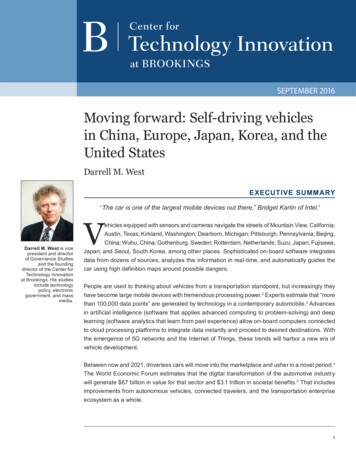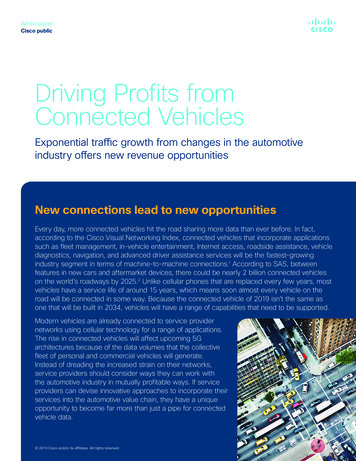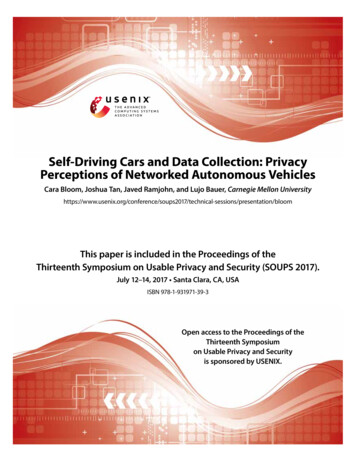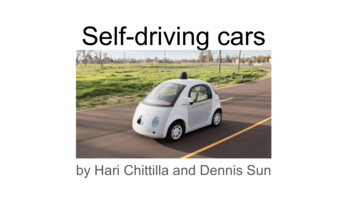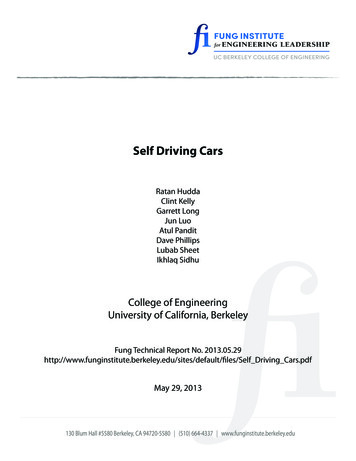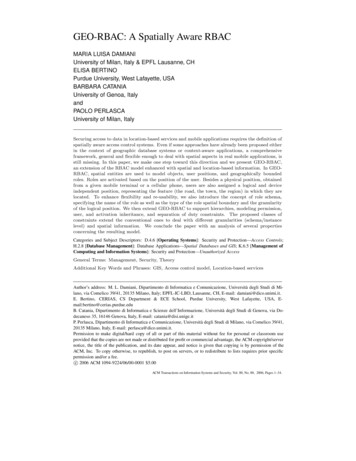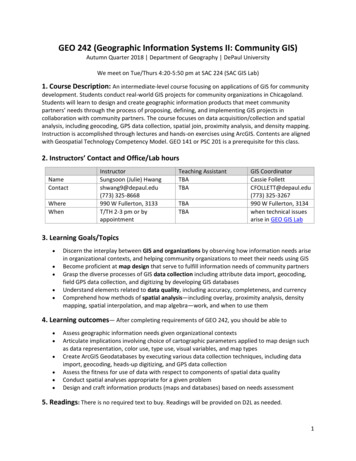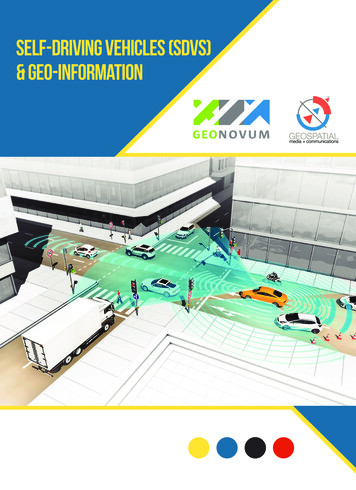
Transcription
Self-Driving Vehicles (SDVs)& Geo-Information
REPORT SELF-DRIVING VEHICLES (SDVS) & GEO-INFORMATIONCONTENTSI.PREFACEII.Background and Scope 4SELF-DRIVING VEHICLES 6IntroductionDirection and TrendsCurrent Scenario: Innovations in the IndustryIII. SELF-DRIVING VEHICLES ECOSYSTEM 12Action Points for the EcosystemIV. GEOSPATIAL AND SELF-DRIVING VEHICLES 17Autonomous Vehicles as Data ProducersGeospatial Technologies - ‘Under the Bonnet’Space TechnologyGeospatial InfrastructureGeographic Information: DataAuthenticity and ReliabilityStandards and StructureV. GOVERNMENT AND SELF-DRIVING VEHICLES 25Establishing an Enabling and Protective Legal Framework Establishing of Open, or Interoperable and Internationally Oriented Data Policyand GovernanceCONCLUSIONANNEXURE 282
REPORT SELF-DRIVING VEHICLES (SDVS) & GEO-INFORMATIONList of Figures & TablesFigure 1.1Where in the World are Self-Driving Vehicles (SDVs) 5Figure 1.2Autonomous Vehicle Deployment Timeline 6Figure 1.3Connected and Autonomous Vehicle Technology Road Map 7Figure 1.4Key Forecasts Figure 1.5Economic Impacts of Autonomous Vehicles in United States and United Kingdom 9Figure 2.1Actions Points for the Autonomous Vehicle Ecosystem Figure 3.1Autonomous Vehicles as Data Producers 17Figure 3.2Sensor Integration in Autonomous Vehicles 18Figure 3.3Under the Bonnet – How the Self-Driving Car works 19Figure 3.4Geographic Information (Data Network) 22Figure 3.5Trends on Autonomous Vehicles 23Figure 4.1Establishment of an Enabling and Protective Legal Framework 25Table 1.1Current Scenario: Innovations in the Industry Table 1.2Industry Directions 1014-158-911AbbreviationsOEMsOriginal Equipment ManufacturersAMS Amsterdam Institute for Advanced MetropolitanSolutionsOGCOpen Geospatial ConsortiumRTKReal Time KinematicsAVAutonomous VehiclesSDVsSelf-Driving VehiclesERTICOEuropean Intelligent Transport OrganizationUKUnited KingdomGNSSGlobal Navigation Satellite SystemUNUnited NationsGPSGlobal Positioning SoftwareUSUnited StatesHDHigh DefinitionV2VVehicle to VehicleITInformation TechnologyV2IVehicle to InfrastructureLiDARLaser Illuminating Detection and RangingV2NVehicle to NetworkMITMassachusetts Institute of TechnologyV2PVehicle to PedestrianNHTSANational Highway Safety AdministrationADASAdvanced Driver Assistance System3
REPORT SELF-DRIVING VEHICLES (SDVS) & GEO-INFORMATIONPREFACETransportation systems globally are on the verge of a major transformation. An innovation that is expected to disruptthe entire automobile industry, the driverless revolution has just begun. With the onset of sophisticated technologicaladvances which combine artificial intelligence and robotics capabilities, interest in ‘Autonomous vehicles’, ‘Selfdriving vehicles’ or ‘driverless’ cars has been surging. Critical to the growth of the ‘Self-driving vehicles’ industry isthe geospatial industry. Equipped with satellite navigation, sensor compliments and other positioning technologies,autonomous vehicles along with geospatial industry brings in a paradigm shift in the driving experience while improvingsafety and efficiency simultaneously.The data information required by self-driving vehicles needs to be rich, diverse, and accurate especially concerningspatial precision and frequency of updates than what is currently in use for day-to-day navigation. Geospatial contentproviders, therefore, will have a crucial role to play to drive an entirely new business model as compared to theconventional ones. These cars will not only ‘need’ geospatial content to build a thriving eco-system but will also‘provide’ content for further use.There is an extreme reliance of the autonomous vehicles on geospatial content. Understanding that maps are goingto be of fundamental nature when it comes to autonomous vehicles, the density of information needed for driverlesscars is going to be much higher and harder to collect. A whole array of sophisticated content providing geospatialtechnologies will exist simultaneously for the successful navigation of self–driving vehicles.BACKGROUND & SCOPECompared to 10 years ago, today, the idea of self-driving vehicles has started to become less far-fetched. Majorautomakers plan to get their autonomous vehicles on the road by 2025 which is less than a decade away. The questionsare many and the answers too little. In this report, we take an in-depth study to understand the crucial role theautomobile industry, geospatial industry and the government together play in bringing evolution in the autonomousvehicles industry. The report has been produced as a knowledge initiative to answer the ‘mystery’ questions aroundthe role of geospatial information in self-driving vehicles, the role of the autonomous vehicle ecosystem and thegovernment,The study, therefore, is largely directed at all the stakeholders of the driverless car ecosystem and the reader wouldgain insights into: The concept of self-driving vehicles Current market trends and benefits and costs associated with driverless cars Action points of the self-driving cars ecosystem Role of the geospatial industry The defining role of the governmentThe report, in summary, examines the core of the driverless car ecosystem i.e. the data and how the other defining factorsof the self-driving cars ecosystem form an inter-linkage to transform the complete landscape of the transportationindustry in the near future.4
REPORT SELF-DRIVING VEHICLES (SDVS) & GEO-INFORMATIONWHERE IN THE WORLD ARE SELF-DRIVING CARS?WATERLOO, ON, CANADAAUSTIN, TX, USAROTTERDAM, THE NETHERLANDSWAGENINGEN, THE NETHERLANDSFORT COLLINS, CO, USABAERUM, NORWAYKIRKLAND, WA, USAHELSINKI, FINLANDSAN FRANCISCOCA, USAMOUNTAIN VIEWCA, USAPHOENIX, AZ, USASION, SWITZERLANDBOSTON, MA, USAPITTSBURGH, PA, USATOKYO, JAPANSINGAPORESHANGHAI, CHINAANN ARBOR, MI, USAFigure 1.1 Where in the World are Self-Driving Vehicles (SDVs)5
REPORT SELF-DRIVING VEHICLES (SDVS) & GEO-INFORMATIONSELF-DRIVING VEHICLESIn today’s context, most of the cars have been digitised toprovide the driver with easier operation and better information such as real-time traffic information, performancedata assessment like speed, music streaming from thecloud, etc. All in all, the cars today are a technologicalmarvel and there is still so much more to come. Transforming the auto industry will be tomorrow’s car that willbe a step change from what is now in the offering.Self-driving vehicles or autonomous vehicles have beena long held dream, a dream that has repeatedly failed tomaterialise. ‘Cars that drive themselves’ are no longera work of science fiction. A very niche and specialisedmarket, the self-driving vehicle industry is making rapidstrides in integrating a lot of technologies from differenteco-system to build the self-driving vehicle.First of all, what are self-driving vehicles? According to theNational Highway Safety Administration (NHTSA), self-driving vehicles are vehicles that can drive themselves withoutany human supervision or input to control the steering,acceleration and braking. The above definition implies thatautonomous technologies imbibed in self-driving vehicles,enable the car to go from Point A to Point B by performingall the required functions for a vehicle to move safely without any human on board. Even though, the common beliefis that the driverless vehicles are a futuristic concept, therace to bring these vehicles to our roads has already begun.These vehicles represent a disruption that is unprecedented in both magnitude and scope.The self-driving car or the smart car achieves autonomyat five levels. These levels are:Level 0 : No-AutomationAt the ‘no-automation’ level, the driver is entirely responsible for the vehicle and its control system – brake,steering, motive power, navigation – at all times.Level 1: Function Specific AutomationAutomation at the ‘function specific level’ involves automation in few i.e. one or two specific control functions.Automation at this level includes electronic stability controlor pre-charged brakes. In such a situation, the automationfeature in vehicles assists with braking while the driverregains control of the vehicle.Level 2: Combined Function AutomationThe Level 2, ‘combined automation function’, involvesautomation of two primary control functions designed towork together. An example at this level could be enabling the adaptive cruise control in combination with lanecentring.Level 3: Limited Self Driving AutomationIn this level of automation, vehicles have full controlof all safety critical functions under different traffic orenvironmental conditions and in those conditions to relyheavily on the vehicle to monitor the complete drivingprocess. The driver is also needed for occasional controlbut with sufficiently comfortable transition time.Level 4: Full Self Driving AutomationAt the final level of automation, the vehicle is designedto perform all functions of driving by itself. The car willbe able to perform all safety-critical driving functionand monitor roadway conditions for an entire trip. InAUTONOMOUS VEHICLE DEPLOYMENT TIMELINE5-10 YEARS10-20 YEARSBEYOND 20 YEARS Controlled, AV-only environments Moderate level of automated driving Low to medium speeds Less restricted environments High level of automated driving Medium to high speed L arge, connected AV networks, allowingmultiple mobility scenarios On demand mobility and fleet services Customizable AVsSOURCE: UN World Urbanization Prospects, World Business Council for Sustainable Development, Factiva, Navigant Research, EY analysisEuropean Commission, directorate General Information Society and Media, Informal document No.: ITS-13-07Figure 1.2 Autonomous Vehicle Deployment Timeline6
REPORT SELF-DRIVING VEHICLES (SDVS) & GEO-INFORMATIONCONNECTED AND AUTONOMOUS VEHICLE TECHNOLOGY ROAD re 1.3 Connected and Autonomous Vehicle Technology Road Mapsuch a design the driver or in this case the passengerwill only have to input the destination in the car but willnot be needed to control the vehicle at any time duringthe trip.DIRECTIONS AND TRENDSindustry. While traditional automaker companies such asAudi, BMW, Toyota, etc., are stepping into the self-drivingvehicle industry by introducing autonomous technologiesthat offer driver support feature, technology giants likeApple and Google are entering directly into the smart carmarket.Self-driving vehicles, also coined as the ‘vehicle of thefuture’ or ‘smart cars’, are already moving in a forwarddirection by taking shape in a variety of forms. Bringing about the next ‘automotive revolution’ is not onlythe automobile manufacturers but also the technologygiants. At present, innovation on self-driving vehiclesis happening in the digital ecosystem, the geospatialecosystem, the automobile ecosystem, etc. to supportthe transformation of the automobile industry. Innovation in all these ecosystems is going to bring about anew level of connectivity among vehicles, new kind ofcars, features like safety sensors, smartphone integration, etc., to progress the autonomous vehicles industry.Driven by both traditional automobile companies as wellas technology giants, there is a rapid acceleration in theinnovation efforts taking place in the autonomous vehicleBringing disruption in the traditional vehicle technologyvalue chain is the gaining traction in the very technologythat makes the driverless cars run. As the technologyinnovation is accelerating, given that the fifth generation of wireless technology makes it possible to streamdata in real time on cloud, the quality of connectivityin between the vehicles has improved. The evolutionof multiple, complex low cost sensors, the computingspeeds to work the artificial intelligence component tosteer the self-driving vehicles, all come together to drivethe self-driving vehicles. Technology innovation companies are investing in new technologies and new servicesalong with the increasing investments being made byautomakers like Tesla, BMW and Audi who are pushingtechnology to the limit.7
REPORT SELF-DRIVING VEHICLES (SDVS) & GEO-INFORMATIONCURRENT SCENARIO: INNOVATIONS IN THE INDUSTRYTeslaAll Tesla vehicles have the hardware needed for full self-driving capability. 8 surround cameras provide 360 degree visibility around the car,12 updated ultrasonic sensors and forward facing radar with enhancedprocessing.2General MotorsGeneral Motors has started testing self-driving Bolt electric vehicleson some public streets in California, Arizona and Michigan after buyingautonomous tech start-up Cruise Automation for 1 Billion3FordFord invests 1billion in an Artificial Intelligence start-up with theintention of having a fully autonomous, level-4 capable vehicle for thecommercial market by 2021. 4Fiat ChryslerFiat Chrysler Automobiles (FCA) has partnered with Waymo (previously the Google Self Driving Project) to carry out detailed research intoautonomous vehicles5HondaHonda has unveiled a new self-driving concept called the CooperativeMobility ecosystem that will ensure vehicle to vehicle communication inconnected cars and smart city infrastructure, reducing traffic congestionand improving road safety. The Cooperative mobility ecosystem aims to“connect the power of artificial intelligence, robotics and big data”. 6VolvoVolvo cars has cemented its position as the leader of automotive safetyinnovation by scoring full six points in the Autonomous EmergencyBraking for Pedestrians (AEB) Pedestrian test procedure.ToyotaToyota is partnering with Stanford University and MIT to research AI andRobotics in order to bring greater autonomy to Toyota Cars by contributing US 50 million over 5 years. 7HyundaiHyundai already has Level 2 smart sense technology, an advanced driverassistance system that includes smart cruise control. The automobilecompany is targeting to release highly autonomous vehicles by 2020 andfully autonomous vehicles by 2030.8BMWBMW is working in collaboration with Inte
The study, therefore, is largely directed at all the stakeholders of the driverless car ecosystem and the reader would gain insights into: The concept of self-driving vehicles Current market trends and benefits and costs associated with driverless cars Action points of the self-driving cars ecosystem Role of the geospatial industry The defining role of the government The .
